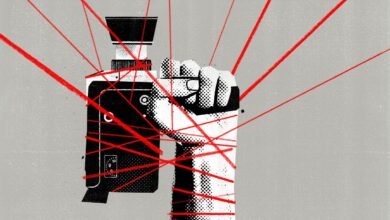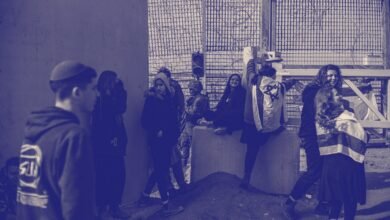Should Police Officers Be More Like U.F.C. Fighters?

Deep inside a municipal building in the Seattle suburbs, Rener Gracie is directing police-academy recruits in an elaborate role-playing scenario. One trainee, who is dressed in all black, like a burglar in a nineties cop show, is “the bad guy”; another, in full patrol uniform, is tasked with arresting him. The bad guy mimes rage, puffing out his chest, while the patrol officer backs away, hands in the air, the very picture of de-escalation. Then Gracie shouts “Action!,” and the uniformed recruit moves to apprehend the suspect, twisting and pretzelling him into an abstract mess before finally cuffing him.
Gracie was commissioned by the Bellevue, Washington, Police Department to coach trainees through different hand-to-hand-combat scenarios. He is six feet four, with a lean, musclebound frame, and a black belt in Brazilian jiu-jitsu, a martial art that his grandfather and great uncles developed about a hundred years ago in Rio de Janeiro, by modifying the traditional Japanese martial art of Judo. “Jujitsu” is a Japanese word that translates to “the gentle art.” Strikes are deëmphasized as compared to in other martial arts, and there are few explosive movements: practitioners drape themselves over their opponents like blankets, slowly progressing into more and more advantageous holds, until they can force their adversaries into submission, using a joint lock, say, or a choke hold. This, Gracie argues, makes it perfect for law enforcement. His “Gracie Jiu-Jitsu” system is designed to help individuals take down larger, stronger opponents without having to resort to more violent force. Gracie has been conducting these kinds of trainings since 2008, but he says that interest from law enforcement spiked in the summer of 2020, after public demand for police reform reached new highs, in the wake of George Floyd’s murder. “ We’re talking twelve, fifteen courses a year to, like, seventy-five courses a year,” Gracie told me.
For more than two years, the Bellevue Police Department’s patrol officers have been taking frequent classes using Gracie’s curriculum as part of their shifts. These lessons have offered an alternative tool for the city’s officers to handle arrests, according to Wendell Shirley, the Bellevue chief of police. “ It’s not violent in that sense of, you know, ‘I’m just gonna dominate, overpower you,’ like you typically see in police physical encounters,” he told me. Shirley, who has been a police officer for nearly three decades, said that he’s taken many courses over the years in defensive tactics. “Most of it was, ‘Hey, you have a baton and you hit them in the back,’ ” he said, whereas the focus of jiu-jitsu is “to get somebody to comply and get them into custody without injuring them or injuring yourself.”
Brazilian jiu-jitsu is a fundamental part of the Ultimate Fighting Championship, in which competitors use a combination of grappling martial arts, such as jiu-jitsu and wrestling, with striking martial arts, like boxing or Muay Thai. The U.F.C. has some powerful friends in the Trump Administration, including President Trump himself, who regularly attends matches and recently said that he would like to stage a U.F.C. fight on the White House grounds. A few months ago, Kash Patel, the director of the F.B.I., mused to more than fifty-five F.B.I. field-office heads that he wants to bring in U.F.C. fighters to train field agents nationwide. According to Reuters, two people briefed on the matter said that current F.B.I. agents characterized the pitch as “surreal” and “wacky.” And yet, Gracie thought this concept was nothing new, because his family has long helped train law enforcement. “When the news went out, I’m, like, yeah, this has been happening for thirty years,” he told me.
In 1989, Gracie’s father, Rorion, opened the first American Brazilian jiu-jitsu school, in Torrance, California. After the Rodney King scandal, Rorion Gracie was brought on to a civilian panel to reëvaluate the training of L.A.P.D. officers. In 1993, he helped organize the very first U.F.C. event, a no-holds-barred tournament of martial artists from around the world. Rener Gracie’s uncle Royce, one of the smallest and least imposing members of the Gracie family, would go on to win that tournament, using jiu-jitsu. In the years that followed, the Gracies transformed their family’s grappling art into a multimillion-dollar empire, which now includes more than two hundred and fifty schools around the world and self-defense programs for both law-enforcement officials and civilians. The Gracies have also been involved in the training of military and police units abroad, most notably in the United Arab Emirates, where Brazilian jiu-jitsu is a national sport and is taught in schools.
To date, Rener Gracie claims that his family has worked with fifteen thousand instructors from thousands of federal, state, and local law-enforcement agencies across the U.S., typically bringing them to his primary location in Torrance for weeklong seminars, where they learn techniques to take back to their respective departments. But despite the widespread nature of those trainings, the relationship between law enforcement and the public has continued to deteriorate, as a litany of killings by police—several of which have occurred as a result of asphyxiation—have led to mass public outcry.
Gracie believes that police officers are generally undertrained and underprepared for physical altercations, leading them to escalate to “the highest force or tool option justifiable,” he said. Training requirements for law-enforcement officials vary from state to state, but police-academy recruits in California require six hundred and sixty-four hours of training before entering into service, which is less than what’s required for a cosmetology license. After completing the academy, recruits are then required to undergo another four hours of “use of force” training every two years. Even if training officers come to Torrance for a weeklong training seminar, Gracie said, the techniques they take back home are practiced sparingly, if at all, by their fellow-officers.
“They’ll dumb it down to four techniques that are trained once every year for a two- or three-hour block,” Gracie said. “And they do an hour of it. You know, talking about putting the handcuffs on, and that’s their arresting-control training for the year.” In an effort to fix the problem, he established the ongoing Brazilian-jiu-jitsu program in the Bellevue Police Department, and he hopes to create more such schools within law-enforcement agencies nationwide.
A couple of months ago, I attended a seminar taught by Gracie at Bellevue’s headquarters. A dozen or so patrol officers, all wearing a white gi—a martial-arts uniform—took turns defending themselves from attacks from behind, using shoulder locks to protect their firearms. As Gracie made his way around the mat offering tips to the officers, a cameraman trailed him, filming promotional content that would later be used to help sell Gracie’s program to other agencies.
At one point, Gracie invited me to jump in and test out a technique that he calls the “safewrap.” The form, which Gracie first developed to assist hospital workers in restraining violent patients, significantly deviates from the way that officers are traditionally taught to restrain and arrest suspects. One of the positions that officers have been trained to restrain suspects in is the prone position: putting them face down, before forcing their arms behind their back and handcuffing them. When a suspect is prone, and an officer is on top of him or her and unable to see the suspect’s face, it’s difficult to assess the situation when a medical emergency occurs. Researchers have warned that chest compression while in this position might cause positional asphyxia or heart attack. (Eric Garner and George Floyd had both been restrained in a prone position by police officers before they died.) The safewrap, meanwhile, involves placing suspects on their side, allowing them to breathe unrestricted.
Gracie and Raphael Park, another instructor, wrapped me up around my chest and legs. When I fell to the mat, Gracie encircled my own arm around my neck, and positioned me on my side, while Park crossed my legs. Gracie then secured my other hand, leaving me in a straitjacket position. He invited me to resist, and so I mustered up everything I’ve got. (For reference, I’m six feet one and two hundred and fifty pounds; I’m also a former Division I wrestler and hold a blue belt in Brazilian jiu-jitsu—which is to say that I thought I’d have a fighting chance.) I kicked and twisted and writhed, but I found myself locked in place. I was also able to breathe freely. Gracie then handcuffed me while I remained on my side.
After class, I spoke to some of the patrol officers in attendance, who were eager to evangelize about the techniques they had used from class. One young officer, Michael Silva, told me that the idea of arresting someone terrified him when he first joined the force. “There’s all these videos of cops getting into fights, and I’ve never really been in a fight like that,” he said. “Like, what would I do?” But a few days prior, Silva had successfully used the safewrap technique to restrain a man. “ At one point, he had my partner in a headlock,” Silva said, of the man. “ It was kind of sloppy getting into it. . . . But we had the theory, the concept of it, and we got him in the safewrap. . . . He had no complaints of pain.” Other officers described similar situations: a modestly sized woman recounted restraining a man twice her size.
Though Gracie and other proponents of jiu-jitsu believe that their approach is safer, it still centers on physical conflict while arresting suspects, making it unlikely that criminal-justice-reform advocates will ever fully embrace the program. As Craig Hanaumi, an officer who does community engagement and serves as one of the program’s instructors, told me, all use of force can appear harsh, and “physically compelling somebody to do something is not pleasant to look at.” In recent years, many critics have also focussed on the pervasive warrior-like culture of policing, which, along with the practice of law-enforcement agents masking, has undermined efforts to improve public perceptions of the police. Gracie has embraced this warrior culture; one might argue that his jiu-jitsu lessons are the culmination of it. At the end of the first day’s final session, Gracie gifted two officers special belts for their training uniforms. The belts are normally used both to hold the training robe closed and to signify one’s rank and experience within Brazilian jiu-jitsu. Gracie’s belts, however, are also designed to resemble the deeply controversial Thin Blue Line flag popularized in response to the Black Lives Matter movement, in 2014. The flag has since been banned by multiple police departments.





